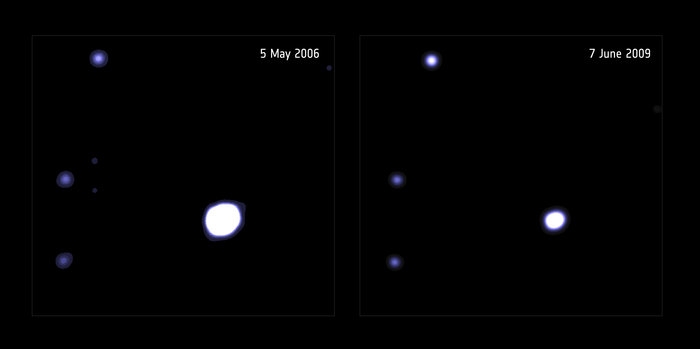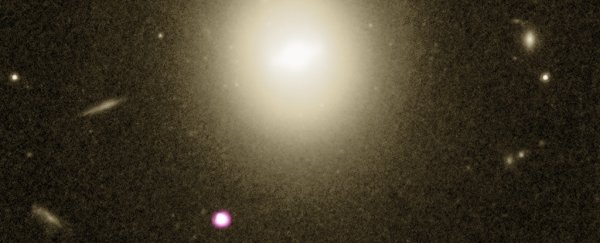Astronomers have spotted what they think is a super-rare cosmic phenomenon: a type of medium-weight black hole proven so elusive that researchers thought it might not exist at all.
There are a few different black hole size categories out there in the Universe. There are the stellar-mass black holes. Those are the ones whose collisions are responsible for the black hole gravitational wave detections made to date, typically less than 100 times the mass of the Sun, or solar masses.
Then there are the supermassive black holes. These are the ones that lurk at the hearts of galaxies, around which everything in the galaxy orbits. Their lower limit is in the range of 100,000 solar masses, but typically they can be millions or billions of solar masses. Sagittarius A*, the supermassive black hole at the centre of the Milky Way, is about 4 million solar masses.
Somewhere in the middle - from 1,000 to 100,000 solar masses - should be another type of black hole, astronomers hypothesise. Yet the intermediate-mass black hole has proven evasive, with possible detections coming up inconclusive.
This has led some astronomers to hypothesise that these so-called "missing link" black holes, thought to be the precursors to their supermassive siblings, simply don't exist.
But now a team of astronomers, led by Dacheng Lin of the University of New Hampshire, have captured what they are calling the best evidence yet for intermediate black holes.
In data from orbiting telescopes NASA's Chandra X-ray Observatory, and NASA's Swift Satellite and ESA's XMM-Newton, they found a huge multi-wavelength flare of radiation from the outskirts of a galaxy 740 million light-years away.
The event, named 3XMM J215022.4−055108 (or J2150−0551 for short), started in October 2003 and fading over the next decade, the same as other radiation flares observed when a black hole tears apart and devours a star.
 (ESA/XMM-Newton; D. Lin et al)
(ESA/XMM-Newton; D. Lin et al)
The distribution of photons depends on the mass of the black hole - which is how the research team was able to determine its size.
"This is incredibly exciting: this type of black hole hasn't been spotted so clearly before," Lin said.
"A few candidates have been found, but on the whole they're extremely rare and very sought after. This is the best intermediate-mass black hole candidate observed so far."
If they exist, though, why are they only seen so rarely? One formation model for intermediate black holes has a plausible explanation.
A 2004 paper proposed that the gravity of a dense stellar cluster could cause the stars therein to fall towards the cluster's centre, forming a star as massive as thousands of Suns. This then would collapse under its own weight, forming an intermediate black hole.
But black holes are only detectable when material, such as a star or a gas cloud, is actively falling into them. By the time one of these clusters had created a black hole, it would have cleared the area within its gravitational reach, meaning there's no material in its vicinity for it to devour - and thus it emits no radiation.
Pertinently, J2150−0551 was found in the centre of a star cluster.
"One of the few methods we can use to try to find an intermediate-mass black hole is to wait for a star to pass close to it and become disrupted - this essentially 'activates' the black hole's appetite again and prompts it to emit a flare that we can observe," Lin explained.
"This kind of event has only been clearly seen at the centre of a galaxy before, not at the outer edges."
The discovery suggests that perhaps there are many more intermediate black holes out there, lurking at the edges of galaxies - they're just dormant, without any stars passing by to snack on, so we don't know they're there.
And J2150−0551 also gives researchers a place to look for more of these elusive beasts - star clusters.
"Our models are currently akin to a scenario in which an alien civilisation observes Earth and spots grandparents dropping their grandchildren at pre-school: they might assume that there's something intermediate to fit their model of a human lifespan, but without observing that link, there's no way to know for sure," said Norbert Schartel of the ESA.
"This finding is incredibly important, and shows that the discovery method employed here is a good one to use."
The paper has been published in the journal Nature Astronomy, and can be read in full on arXiv.
